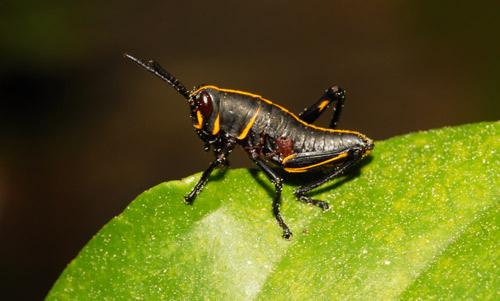The first animal I observed upon entering the Everglades National park was a Romalea microptera or the eastern lubber grasshopper. The lubber grasshopper is one
of the biggest insects you will find in the Southern United States or anywhere, ranging from three to five inches long. It is so big that some people, like myself may think it is actually a turtle from a distance. These grasshoppers have a very distinct bright yellow and orange color pattern which make it very easy to identify. The lubber grasshoppers bright colors are a clear warning sign to predators that it poisonous. the lubber grasshoppers secret a toxin foam. Because of these toxins birds, and other insects avoid them so the lubber grasshoppers has no natural known predators. Juvenile lubber grass hoppers are black and have a yellow band along its back. After the grasshopper molts two to three times in begins to develop the bright yellow and orange color patterns.
The lubber grass hopper gets its name from being very awkward and clumsy when walking or flying in very short burst. Due to its heavy size it can not fly, but can still jump. Their population is distributed from Texas to South Carolina. We observed many mating pairs of lubber grasshoppers while walking along the Gumbo Limbo trail, most of which were around 3 inches long, with the males being smaller then the females. After they mate the female grasshopper will deposit her eggs around a protected body of water in a pod containing about thirty eggs. This is why we saw a significant number of Lubber grasshoppers on the Gumbo Limbo trail which bordered a water way. These grasshoppers also like areas which are frequently flooded because they provide a refuge for the grasshoppers nymphs. These grasshoppers can be considered a pest to the locals because in large numbers they can cause severe damage to farmers crops, and gardens. Some towns will even ask you to kill them if you come into contact with them.
One thing that makes these grasshoppers interesting and hard to control is that most insecticides are ineffective against the grasshoppers. Recently their populations have exploded, although its not clear these increases in populations may be due to the man made canals an an increase of stagnate water.One thing I noticed when handling the lubber grasshopper is that it secretes some of the toxins through its mouth, but it is none aggressive. They also were out mating in the open which i thought was interesting because usually that would be dangerous for most animals.
http://www.wildflorida.com/wildlife/insects/Eastern_Lubber_Grasshopper.php
http://www.tampabay.com/features/homeandgarden/kill-kill-kill-the-eastern-lubber-grasshopper/1223224
#everglades #Grasshoppers #Gumbolimbotrail #stockton #notaturtle #Florida


I am not a big fan of bugs but these grasshoppers were very very interesting. I think it’s awesome how the color of these bugs are determined by the tempature in which they were born in. I also observed a large amount of these when I was walking through the park. If pesticides have no affect on them and there are no known preparatory, I wonder what will kill them so that their population does not get overwhelming!
ReplyDeleteWait so nothing eats them?????? So is their anything that controls their number,such as a disease or animal that can handle them. If not then i can see how bad these little bugs can be to the local environment. I am surprised there were no postings or anything around the trail site, due to their insane numbers that were located there.
ReplyDelete